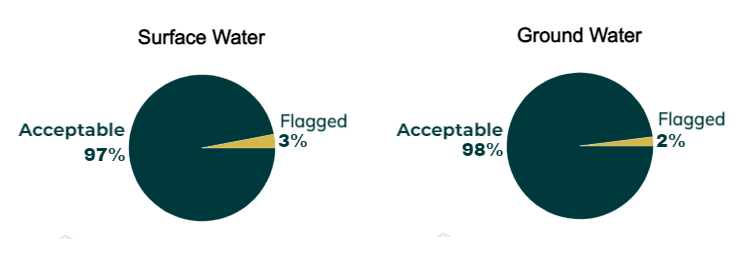Citizen awareness and access to independently verified data is important, especially when it comes to a resource as important as ground and surface water. The Stibnite Advisory Council launched the Independent Water Monitoring Program to give community members access to ground and surface water quality data from the Stibnite Gold Project verified by an objective third-party.
The goal of the Independent Water Monitoring Program is to enhance the transparency of the Stibnite Gold Project and help ensure the company’s data is representative of the environmental conditions present at site. To achieve this the Stibnite Advisory Council hired the Idaho Water Resources Research Institute from the University of Idaho to collect, analyze and report on ground and surface water samples in conjunction with an EPA-certified lab twice a year.
Through the program, the Idaho Water Resources Research Institute will visit the site twice a year to collect samples from nine different surface and ground water test sites, plus two quality control sites, to be analyzed for different chemical components. The samples are divided between Perpetua Resources and Idaho Water Resources Research Institute to monitor, test, and evaluate.
2023 Water Quality Data
The Stibnite Advisory Council’s Independent Water Monitoring Program reported consistent results between its ground and surface water data and that of Perpetua Resources in its third year of testing.

This infographic presents the results from an interlaboratory comparison between two analytic laboratories (SVL Analytical Inc., Kellogg, Idaho and Anatek Labs, Inc., Moscow, Idaho) that tested concentrations of water quality analytes from waters collected at the Stibnite Gold Project Site in 2022.
Methods: Surface and groundwater samples were collected from 9 sites plus 2 for quality control on August 8 and July 18, 2023, respectively. A total of 25 water quality parameters were evaluated for each of the 11 samples resulting in a total of 275 sample-analyte combinations per sampling event. Collection of surface and groundwater for laboratory analysis occurred via split sampling, that is, the separation of a water sample into two parts such that each part was representative of the original sample. Water was taken from a single source (e.g., a groundwater well or stream) then divided in two, with each sample independently analyzed by Anatek Labs (Moscow, ID) and SVL Analytical (Kellogg, ID). Data were transmitted to the U of I for assessment of differences in the analyses reported by the two laboratories.
Results: Results of the 275 surface water analysis comparisons indicated that 95.3% (n=262) were acceptable and 4.7% (n=13) were flagged. Results of the 275 comparisons of groundwater analyte concentrations indicated that 97.5% (n=268) were acceptable and 2.5% (n=7) were flagged. Most flagged values were for very low concentrations close to the method detection limits where analyses tend to be less accurate and therefore more likely to be flagged. For more information, please contact Dr. Timothy Link ([email protected]) with the University of Idaho’s College of Natural Resources.

2022 Water Quality Data
Results from the second year of the Independent Water Monitoring Program showed the exact same results for the August and October testing periods. Results from May showed a 97 percent match and the results from July showed a 95 percent match, both those results show consistency across the data and are within the accepted percent differences.

This infographic presents the results from an interlaboratory comparison between two analytic laboratories (SVL Analytical Inc., Kellogg, Idaho and Anatek Labs, Inc., Moscow, Idaho) that tested concentrations of water quality analytes from waters collected at the Stibnite Gold Project Site in 2022.
Methods: Four, day-long water collection events occurred in 2022; two focused on surface waters, two on groundwater (Figure 1). Split-sampling was conducted with an aliquot of a water sample being analyzed by both laboratories. Results were generated from analysis of 25 analytes measured at 9 sites during each of the four water sampling campaigns (total =225 analyte-site combinations per each sampling event).
Results: Analyte estimates were consistently (95-100%) within accepted relative percent differences, as per pre-established guidelines (Figure 1). Neither SVL Analytical nor Anatek Labs consistently overestimated the other, nor were there any consistent biases in the data relative to individual analytes or locations.

2021 Water Quality Data
The program collected its first samples in the summer of 2021. The first test results show the results between the two labs were consistent 97% of the time for surface and 98% of the time for ground water.

RESOURCES
It is important that the community has full visibility into the Independent Water Monitoring Program. Below you will find all of the reports and summaries provided by the Idaho Water Resources Research Institute and press releases on the results of the program from the Stibnite Advisory Council.
![]() 2021 Interlaboratory Comparison Report
2021 Interlaboratory Comparison Report
![]() Summary 2021 Interlaboratory Comparison Report
Summary 2021 Interlaboratory Comparison Report
![]() Release: First Independent Water Monitoring Program Results Released
Release: First Independent Water Monitoring Program Results Released
![]() Release: Stibnite Advisory Council Launches Independent Water Monitoring Program
Release: Stibnite Advisory Council Launches Independent Water Monitoring Program
